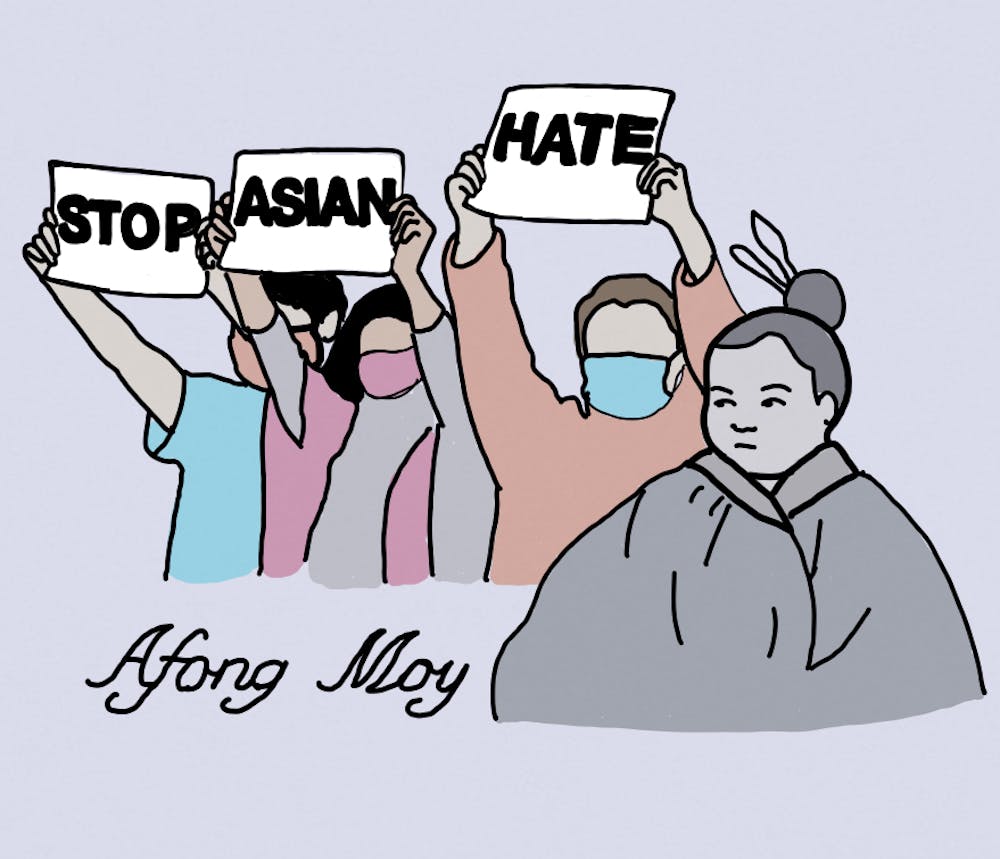A day before the Atlanta shootings, I was rejoicing because for the first time ever, “Minari,” a film by and about Asian Americans, was nominated for six Oscars. I cried tears of joy, as never before had two Asian men been nominated in the Best Actor category. As a young Asian American actor, I felt seen, I felt inspired, I felt hopeful.
But a mere 24 hours later, eight people, including six Asian women, were murdered because the gunman “had a bad day.”
I think about how conditional acceptance for Asian Americans is, how our difference is etched on our skin, how at one moment we can be on the mountaintop and the next we are being murdered for no reason other than the color of our skin. I think about how as much as we can try to “assimilate,” to pretend our racial difference can be traversed through drinking boba or sharing memes on “Subtle Asian Traits,” our history is never erased. To be Asian American is to hold legacies of exclusion, hate, and violence in your body, but be told that you are accepted, that you belong, that you are a model citizen and a model American.
To be Asian American is to also hold inside of you the histories and sacrifices of those who came before you. As I think about the six Asian women killed in Atlanta, I also think about Afong Moy, the first known Chinese woman to arrive in America in 1834. She was exhibited in museums across the country as a curiosity and an object. For over a decade, she lived her life on display — eating, walking, drinking tea — under the gaze of white audiences, a gaze that rendered her backwards and inferior, something to conquer and possess, not to humanize and respect.
In his play “The Chinese Lady,” Lloyd Suh injects a new life and voice to Afong Moy. Moy tells her story to the audience from beginning to end. As a theatre certificate student, I chose to propose this show this year as my thesis performance because when I first read the play, Afong Moy felt like a friend. She felt like someone I knew: all at once a distant Chinese ancestor, my Chinese grandmother, my immigrant Chinese mother, and myself. She started her life in America, like all the immigrants who came before and after her, excited and hopeful, eager to see America, to learn English, to use forks, and to share her culture with Americans in the hopes that it could lead to empathy and compassion across an ocean of difference.
But how could she know that when Americans saw her, all they saw was an object, a decoration, an ornament? All they saw was a monstrosity, something less than human, from her small, slanted eyes, to her tiny, bound feet. All they saw was something inherently foreign and despicable, something to spit at, to push, to shove, to kill, and eventually, to ban from their country all together. In 1850, Afong Moy disappeared completely from our historical record; no one knows what happened to her. Yet, she still survives today.
Afong Moy continues to live in the strong Asian women in my life and in myself. She lives in the wrinkles of my mother’s eyes as she squints into the California sun after landing in America for the first time. She lives in the palms of our hands, where we hold fat little dumplings and delicately pinch together the edges. She lives in the tears in my eyes when I am laughed at and told for the first time at age 12 that I am not American, that I do not belong in the place that I call home. She lives in the candle I hold in my hand as I mourn the deaths of six Asian women and two other victims at the hands of a white supremacist and terrorist.
She lives because over 200 years later, the fight is still not over. Asian Americans are still struggling to be seen, not simply for the complexity of our language, the color of our skin, or the shape of our eyes, but for our humanity, for the shared humanity that lives in each of us. Six Asian women were killed in Atlanta not because the murderer was addicted to sex, but because he was addicted to the power he could wield over Asian women — over objects inferior to him, objects that existed purely for his enjoyment, devoid of their own voice, power, or control.
Objects like Afong Moy.
Giving life to Afong Moy these past few months has brought me so much healing, as well as a deeper understanding of the legacy and strength of the Asian women who have come before me. It has given me the strength to not feel defeated by the tragedy borne by the Asian American community but determined to fight back. Even though Afong Moy endures so much pain, loss, and loneliness, she does not despair. She looks ahead to those who come after her — to people like myself, to people like you.
Jacy Duan is a senior from Los Angeles, Calif. She can be reached at jduan@princeton.edu. More information on watching the filmed performance of “The Chinese Lady” can be found here.









